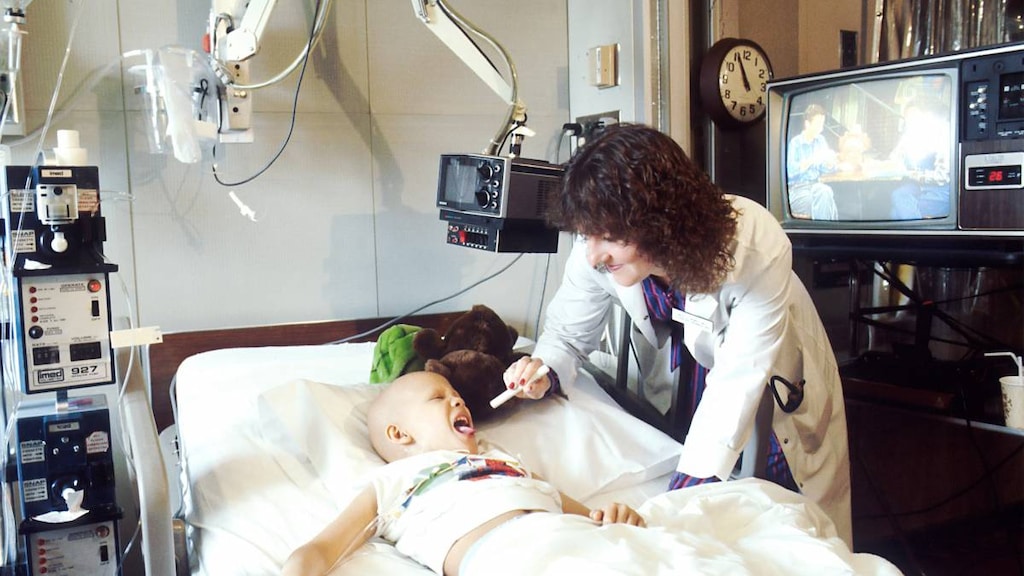Boxed Warning
Embryo-fetal toxicity:
Glasdegib can cause embryo-fetal death or severe birth defects when administered to a pregnant woman. Glasdegib is embryotoxic, fetotoxic, and teratogenic in animals. Conduct pregnancy testing in females of reproductive potential prior to initiation of glasdegib treatment. Advise females of reproductive potential to use effective contraception during treatment with glasdegib and for at least 30 days after the last dose. Advise males of the potential risk of glasdegib exposure through semen and to use condoms with a pregnant partner or a female partner of reproductive potential during treatment with glasdegib and for at least 30 days after the last dose to avoid potential drug exposure.
Dosage Forms
Excipient information presented when available (limited, particularly for generics); consult specific product labeling.
Tablet, Oral, as maleate:
Daurismo: 25 mg, 100 mg
Pharmacology
Mechanism of Action
Glasdegib is a small molecule inhibitor of the Hedgehog pathway. Glasdegib binds to and inhibits Smoothened (SMO), which is a transmembrane protein involved in hedgehog signal transduction. Glasdegib blocks the translocation of SMO into cilia and prevents SMO-mediated activation of downstream Hedgehog targets (Cortes 2018). In an animal AML model, glasdegib (in combination with low-dose cytarabine) reduced the percentage of CD45+/CD33+ blasts in the bone marrow and inhibited increases in tumor size to a greater extent than either agent alone.
Pharmacokinetics/Pharmacodynamics
Distribution
188 L
Metabolism
Primarily hepatic via CYP3A4, with minor contributions by CYP2C8 and UGT1A9
Excretion
Urine: 49% (17% as unchanged drug); Feces: 42% (20% as unchanged drug)
Time to Peak
1.3 to 1.8 hours
Half-Life Elimination
17.4 hours ± 3.7 hours
Protein Binding
91% to human plasma proteins
Use: Labeled Indications
Acute myeloid leukemia: Treatment of newly-diagnosed acute myeloid leukemia (in combination with low-dose cytarabine) in adult patients who are ≥75 years of age or who have comorbidities that preclude use of intensive induction chemotherapy.
Limitation of use: Has not been studied in patients with severe renal impairment or moderate-to-severe hepatic impairment.
Contraindications
There are no contraindications listed in the manufacturer's labeling.
Dosage and Administration
Dosing: Adult
Note: Verify pregnancy status of females of reproductive potential within 7 days prior to therapy initiation.
Acute myeloid leukemia: Adults ≥75 years or with comorbidities: Oral: 100 mg once daily (in combination with subcutaneous low-dose cytarabine) for a minimum of 6 (28-day) cycles (to allow time for clinical response) or until disease progression or unacceptable toxicity
Missed or vomited doses: If a dose is missed, administer the dose as soon as possible and at least 12 hours prior to the next scheduled dose; return to the normal schedule the following day. Do not administer 2 doses within 12 hours. If a dose is vomited, do not administer a replacement dose. Resume dosing with the next scheduled dose.
Dosing: Geriatric
Refer to adult dosing.
Dosing: Adjustment for Toxicity
Hematologic toxicity:
Neutrophils <500/mm3 for more than 42 days (in the absence of disease): Discontinue glasdegib (and low-dose cytarabine) permanently.
Platelets <10,000/mm3 for more than 42 days (in the absence of disease): Discontinue glasdegib (and low-dose cytarabine) permanently.
Nonhematologic toxicity:
QTc prolongation (on at least 2 separate electrocardiograms [ECGs]:
QTc interval >480 to 500 msec: Assess electrolytes and supplement as necessary; review and adjust concomitant medications with known QTc interval-prolonging effects. Monitor ECGs at least weekly for 2 weeks following resolution of QTc prolongation to ≤480 msec.
QTc interval >500 msec: Interrupt glasdegib therapy. Assess electrolytes and supplement as necessary; review and adjust concomitant medications with known QTc interval-prolonging effects. When QTc interval returns to within 30 msec of baseline or ≤480 msec, resume glasdegib at a reduced dose of 50 mg once daily. Monitor ECGs at least weekly for 2 weeks following resolution of QTc prolongation. Consider increasing the glasdegib dose back to 100 mg once daily if an alternate etiology for the QTc prolongation is identified.
QTc interval prolongation with life-threatening arrhythmia: Discontinue glasdegib permanently.
Other toxicity:
Grade 3: Interrupt glasdegib and/or low-dose cytarabine until symptoms reduce to mild or return to baseline. Resume glasdegib at the same dose or at a reduced dose of 50 mg (also resume low-dose cytarabine at the same or a reduced dose). If toxicity recurs, discontinue glasdegib (and low-dose cytarabine) unless toxicity is attributable to glasdegib only.
Grade 4: Discontinue glasdegib (and low-dose cytarabine) permanently.
Administration
Oral: Administer with or without food at approximately the same time each day. Do not split or crush the tablets.
Storage
Store at 20°C to 25°C (68°F to 77°F); excursions permitted between 15°C to 30°C (59°F to 86°F).
Drug Interactions
Aprepitant: May increase the serum concentration of CYP3A4 Substrates (High risk with Inhibitors). Monitor therapy
Bosentan: May decrease the serum concentration of CYP3A4 Substrates (High risk with Inducers). Monitor therapy
Clofazimine: May increase the serum concentration of CYP3A4 Substrates (High risk with Inhibitors). Monitor therapy
Conivaptan: May increase the serum concentration of CYP3A4 Substrates (High risk with Inhibitors). Avoid combination
CYP3A4 Inducers (Moderate): May decrease the serum concentration of CYP3A4 Substrates (High risk with Inducers). Monitor therapy
CYP3A4 Inducers (Strong): May decrease the serum concentration of Glasdegib. Avoid combination
CYP3A4 Inhibitors (Moderate): May decrease the metabolism of CYP3A4 Substrates (High risk with Inhibitors). Monitor therapy
CYP3A4 Inhibitors (Strong): May increase the serum concentration of Glasdegib. Management: Consider alternatives to this combination when possible. If the combination must be used, monitor closely for evidence of QT interval prolongation and other adverse reactions to glasdegib. Consider therapy modification
Dabrafenib: May decrease the serum concentration of CYP3A4 Substrates (High risk with Inducers). Management: Seek alternatives to the CYP3A4 substrate when possible. If concomitant therapy cannot be avoided, monitor clinical effects of the substrate closely (particularly therapeutic effects). Consider therapy modification
Deferasirox: May decrease the serum concentration of CYP3A4 Substrates (High risk with Inducers). Monitor therapy
Duvelisib: May increase the serum concentration of CYP3A4 Substrates (High risk with Inhibitors). Monitor therapy
Erdafitinib: May decrease the serum concentration of CYP3A4 Substrates (High risk with Inducers). Monitor therapy
Erdafitinib: May increase the serum concentration of CYP3A4 Substrates (High risk with Inhibitors). Monitor therapy
Fosaprepitant: May increase the serum concentration of CYP3A4 Substrates (High risk with Inhibitors). Monitor therapy
Fosnetupitant: May increase the serum concentration of CYP3A4 Substrates (High risk with Inhibitors). Monitor therapy
Fusidic Acid (Systemic): May increase the serum concentration of CYP3A4 Substrates (High risk with Inhibitors). Avoid combination
Haloperidol: QT-prolonging Agents (Indeterminate Risk - Avoid) may enhance the QTc-prolonging effect of Haloperidol. Monitor therapy
Idelalisib: May increase the serum concentration of CYP3A4 Substrates (High risk with Inhibitors). Avoid combination
Ivosidenib: May decrease the serum concentration of CYP3A4 Substrates (High risk with Inducers). Monitor therapy
Larotrectinib: May increase the serum concentration of CYP3A4 Substrates (High risk with Inhibitors). Monitor therapy
Lorlatinib: May decrease the serum concentration of CYP3A4 Substrates (High risk with Inducers). Management: Avoid concurrent use of lorlatinib with any CYP3A4 substrates for which a minimal decrease in serum concentrations of the CYP3A4 substrate could lead to therapeutic failure and serious clinical consequences. Consider therapy modification
MiFEPRIStone: May increase the serum concentration of CYP3A4 Substrates (High risk with Inhibitors). Management: Minimize doses of CYP3A4 substrates, and monitor for increased concentrations/toxicity, during and 2 weeks following treatment with mifepristone. Avoid cyclosporine, dihydroergotamine, ergotamine, fentanyl, pimozide, quinidine, sirolimus, and tacrolimus. Consider therapy modification
Netupitant: May increase the serum concentration of CYP3A4 Substrates (High risk with Inhibitors). Monitor therapy
Palbociclib: May increase the serum concentration of CYP3A4 Substrates (High risk with Inhibitors). Monitor therapy
QT-prolonging Agents (Highest Risk): QT-prolonging Agents (Indeterminate Risk - Avoid) may enhance the QTc-prolonging effect of QT-prolonging Agents (Highest Risk). Management: Monitor for QTc interval prolongation and ventricular arrhythmias when these agents are combined. Patients with additional risk factors for QTc prolongation may be at even higher risk. Monitor therapy
Sarilumab: May decrease the serum concentration of CYP3A4 Substrates (High risk with Inducers). Monitor therapy
Siltuximab: May decrease the serum concentration of CYP3A4 Substrates (High risk with Inducers). Monitor therapy
Simeprevir: May increase the serum concentration of CYP3A4 Substrates (High risk with Inhibitors). Monitor therapy
Stiripentol: May increase the serum concentration of CYP3A4 Substrates (High risk with Inhibitors). Management: Use of stiripentol with CYP3A4 substrates that are considered to have a narrow therapeutic index should be avoided due to the increased risk for adverse effects and toxicity. Any CYP3A4 substrate used with stiripentol requires closer monitoring. Consider therapy modification
Tocilizumab: May decrease the serum concentration of CYP3A4 Substrates (High risk with Inducers). Monitor therapy
Adverse Reactions
>10%:
Cardiovascular: Edema (30%), atrial arrhythmia (13%), chest pain (12%)
Central nervous system: Fatigue (36%), dizziness (18%), headache (12%)
Dermatologic: Skin rash (20%)
Endocrine & metabolic: Hyponatremia (11% to 54%), hypomagnesemia (33%), hyperkalemia (16%), hypokalemia (15%), weight loss (13%)
Gastrointestinal: Nausea (29%), decreased appetite (21%), dysgeusia (21%), mucositis (21%; grade ≥3: 1%), constipation (20%), abdominal pain (19%), diarrhea (18%), vomiting (18%)
Hematologic & oncologic: Anemia (43%; grade ≥3: 41%), hemorrhage (36%; grade ≥3: 6%), febrile neutropenia (31%; grade ≥3: 31%), thrombocytopenia (30%; grade ≥3: 30%), decreased white blood cell count (11%; grade ≥3: 11%)
Hepatic: Increased serum aspartate aminotransferase (28%), increased serum bilirubin (25%), increased serum alanine aminotransferase (24%), increased serum alkaline phosphatase (23%)
Neuromuscular & skeletal: Musculoskeletal pain (30%), increased creatine phosphokinase in blood specimen (16%), muscle spasm (15%)
Renal: Increased serum creatinine (96%), renal insufficiency (19%)
Respiratory: Dyspnea (23%), pneumonia (19%), cough (18%)
Miscellaneous: Fever (18%)
1% to 10%:
Cardiovascular: Prolonged QT interval on ECG (4% to 5%)
Infection: Sepsis (7%)
Frequency not defined: Endocrine & metabolic: Hypophosphatemia
Warnings/Precautions
Concerns related to adverse effects:
- QTc prolongation: QTc prolongation and ventricular arrhythmias, including ventricular fibrillation and ventricular tachycardia may occur. A small percentage of patients in a clinical trial were found to have a QTc interval >500 msec; some patients had an increase from baseline >60 msec. Patients with baseline QTc >470 msec (or with a history of long QT syndrome or uncontrolled cardiovascular disease) were excluded from the clinical trial. Concomitant use of drugs known to prolong the QTc interval and CYP3A4 inhibitors may increase the risk of QTc interval prolongation. Monitor electrocardiograms (ECGs) and electrolytes; patients with congenital long QT syndrome, heart failure, electrolyte abnormalities, or those on concomitant medications known to prolong the QTc interval may require more frequent ECG monitoring. QTc interval prolongation may require therapy interruption, dose reduction, and/or permanent discontinuation.
Concurrent drug therapy issues:
- Drug-drug interactions: Potentially significant interactions may exist, requiring dose or frequency adjustment, additional monitoring, and/or selection of alternative therapy. Consult drug interactions database for more detailed information.
Special populations:
- Pregnancy: Glasdegib use is not recommended in pregnant females. [US Boxed Warning]: Glasdegib can cause embryo-fetal death or severe birth defects when administered to a pregnant female. Glasdegib is embryotoxic, fetotoxic, and teratogenic in animals. Conduct pregnancy testing in females of reproductive potential prior to initiation of glasdegib treatment. Advise females of reproductive potential to use effective contraception during glasdegib treatment and for at least 30 days after the last glasdegib dose. Advise males of the potential risk of glasdegib exposure through semen and to use condoms (even after vasectomy) with a pregnant partner or a female partner of reproductive potential during glasdegib treatment and for at least 30 days after the last glasdegib dose to avoid potential drug exposure.
Other warnings/precautions:
- Blood donation: Advise patients not to donate blood or blood products during glasdegib treatment and for at least 30 days after the last glasdegib dose.
- Sperm donation: Advise patients not to donate sperm during glasdegib treatment and for at least 30 days after the last glasdegib dose.
Monitoring Parameters
Monitor complete blood counts, electrolytes, renal, and hepatic function prior to therapy and at least once weekly for the first month; monitor electrolytes and renal function once monthly for the duration of therapy (or as clinically indicated); obtain serum creatine kinase levels prior to therapy initiation and as clinically indicated; pregnancy test (within 7 days prior to starting glasdegib treatment in females of reproductive potential); monitor ECGs prior to therapy initiation, ~1 week after initiation, and then once monthly for the next 2 months; more frequent monitoring may be necessary (repeat ECG if abnormal). Monitor adherence.
Pregnancy
Pregnancy Considerations
Glasdegib use is not recommended in pregnant females. [US Boxed Warning] Glasdegib can cause embryo-fetal death or severe birth defects when administered to a pregnant female. Glasdegib is embryotoxic, fetotoxic, and teratogenic in animals. Glasdegib inhibits the Hedgehog pathway which is critical to fetal development (Walterhouse 1999).
[US Boxed Warning] Conduct pregnancy testing in females of reproductive potential prior to initiation of glasdegib treatment. Pregnancy testing should be conducted within 7 days prior to starting glasdegib treatment. Advise females of reproductive potential to use effective contraception during glasdegib treatment and for at least 30 days after the last glasdegib dose. Advise males of the potential risk of glasdegib exposure through semen and to use condoms (even after vasectomy) with a pregnant partner or a female partner of reproductive potential during glasdegib treatment and for at least 30 days after the last glasdegib dose to avoid potential drug exposure. Semen should not be donated during treatment and for at least 30 days after the last dose of glasdegib. Based on animal data, males should consider effective fertility preservation prior to therapy.
Health care providers are encouraged to enroll females inadvertently exposed to glasdegib during pregnancy to the Pfizer pregnancy registry (800-438-1985).
Patient Education
- Discuss specific use of drug and side effects with patient as it relates to treatment. (HCAHPS: During this hospital stay, were you given any medicine that you had not taken before? Before giving you any new medicine, how often did hospital staff tell you what the medicine was for? How often did hospital staff describe possible side effects in a way you could understand?)
- Patient may experience nausea, vomiting, lack of appetite, abdominal pain, constipation, diarrhea, change in taste, hair loss, back pain, bone pain, joint pain, muscle pain, neck pain, mouth sores, mouth pain or irritation, gum pain or irritation, weight loss, muscle spasm, or headache. Have patient report immediately to prescriber signs of bleeding (vomiting blood or vomit that looks like coffee grounds; coughing up blood; blood in the urine; black, red, or tarry stools; bleeding from the gums; abnormal vaginal bleeding; bruises without a reason or that get bigger; or any severe or persistent bleeding), signs of kidney problems (unable to pass urine, blood in the urine, change in amount of urine passed, or weight gain), signs of electrolyte problems (mood changes, confusion, muscle pain or weakness, abnormal heartbeat, seizures, lack of appetite, or severe nausea or vomiting), dizziness, passing out, fast heartbeat, slow heartbeat, abnormal heartbeat, chest pain, severe loss of strength and energy, chills, sore throat, cough, shortness of breath, or edema (HCAHPS).
- Educate patient about signs of a significant reaction (eg, wheezing; chest tightness; fever; itching; bad cough; blue skin color; seizures; or swelling of face, lips, tongue, or throat). Note: This is not a comprehensive list of all side effects. Patient should consult prescriber for additional questions.
Intended Use and Disclaimer: Should not be printed and given to patients. This information is intended to serve as a concise initial reference for health care professionals to use when discussing medications with a patient. You must ultimately rely on your own discretion, experience, and judgment in diagnosing, treating, and advising patients.



